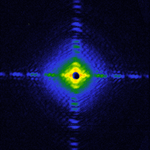HDI processing of a single diffraction experiment. (a) Hologram of the lithographically grown gold nanostructure (block letter P) (b) Central part of the modulus of the Fourier transformed hologram, imaging the object. (c) Visualization of the central object geometry as derived from the electron density profile.
(for details see: PRL Paper)

Scientists from HASYLAB/DESY , together with colleagues from BESSY and ESRF (France), determined the absolute electron density of a lithographically grown nanostructure with 25 nm resolution. L. Stadler, G. Grübel and their colleagues were able to identify this structure by combining hard X-ray Fourier transform holography with iterative phase retrieval methods.
While holography immediately reveals an precise image of the object, they deployed in addition iterative phase retrieval algorithms for pushing the resolution close to the diffraction limit. The experiments were performed at Beamline ID10C at the ESRF (Grenoble, France). The use of hard X-rays (8 keV) eliminates practically all constraints on sample environment. It enables a destruction-free investigation of relatively thick or buried samples, making holographic diffraction imaging a very attractive tool for materials science. They showed that HDI with hard X-rays is an excellent technique for determining electron density profiles on the nanoscale.
Similar experiments will probably be carried out at future hard x-ray free electron laser sources, like the European XFEL, where diffraction patterns can be collected within a single shot at the time scale of ~ 10 fs. Such future experiments will open fascinating possibilities for imaging of fast dynamic processes.
(from: ...Paper and authors).
The results appeared in Phys. Rev. Lett. 100, 245503 (2008) .
| Further Links |
|






